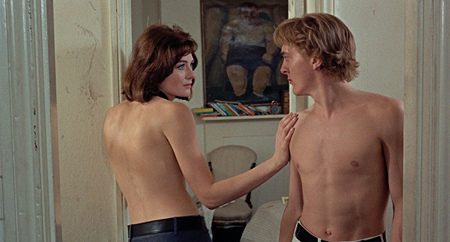
“A MOD MURDER
MYSTERYâ€
By Raymond Benson
Michelangelo
Antonioni’s Blowup (it’s spelled this
way in the film credits, but on theatrical posters and advertising it was
called Blow-Up) was a landmark,
envelope-pushing film that caused quite a stir. For one thing, it was one of
the nails in the coffin of the U.S. Production Code, paving the way for the
elimination of cinematic censorship and the eventual creation of the movie
ratings. Its depiction of nudity, sexual attitudes, and recreational drugs
crossed the line for late 1966. Nevertheless, newspaper ads got away with
simply proclaiming that the picture was “Recommended for Mature Audiences,â€
since this was prior to the ratings themselves.
Blowup also stands as a
cultural landmark in that it captures that moment of time called “Swinging
London.†Everything was “modâ€â€”music, fashion, art... even groups of youths were
called “mods.†Antonioni’s film could serve as a time capsule for that period
of artistic rebellion. It’s also a curiosity in that it was an Italian-British
co-production, financed by Hollywood—but it definitely comes off as “English.†The
filmmaker received his only Best Director Oscar nomination for the picture, and
he shared a nomination for Original Screenplay with Tonino Guerra.
The
story concerns Thomas, a professional photographer (charismatically portrayed
by David Hemmings), who we follow as he goes about his daily routine of
shooting gorgeous fashion models and whatever else strikes his fancy as he
roams London. He’s estranged from his wife (Sarah Miles), and it’s apparent
they have an open relationship (how very mod of them!). One day, while
strolling through Maryon Park (which still looks practically the same today),
Thomas spies a lovely young woman (Vanessa Redgrave) with an older man. He
snaps pictures without the couple knowing it, but then the woman chases Thomas
down and demands to have the film. He won’t give it up—the pictures are going
into an art book he’s planning to publish. When he develops the roll, Thomas
discovers that a murder may have occurred. Later on that night, he returns to
the park and finds that, indeed, the older man’s body is lying in the grass. The
mystery of the crime becomes Thomas’ obsession.

There
isn’t much plot beyond that. Instead, Antonioni presents an existential
treatise on the nature of seeing and not-seeing, or perhaps imagination vs.
reality. Thomas seems to have everything a good-looking, talented man could
want—his pick of “birds†(yes, that was the slang for “girls†then), money, a
fancy car, and the freedom to chase the muse. And yet, there is something
missing in his life and it soon becomes obvious that he’s not very happy. The
uncovering of the mystery further shakes him out of party mode and forces him
to face the real world. It’s a theme Antonioni explores in several of his
works.
The
film is a visual feast. The sets are filled with the modern art of the period
and “Twiggyâ€-style clothing. The London locations are used to a great
advantage, and many of these are revisited in the new documentary on the making
of the film that is included as a supplement on the disk. The soundtrack is
also “hipâ€â€”Herbie Hancock provides the jazz score, and the Yardbirds (which at
the time included Jeff Beck and Jimmy Page) appear as themselves and perform at
an underground club. The ménage à trois scene that caused
all the fuss with the Production Code and features Hemmings, Jane Birkin (who
at the time was married to composer John Barry), and Gillian Hills, is wild and
raucous and was probably pretty shocking at the time—but today it would barely
classify for an “R†rating in the U.S.

The
Criterion Collection’s new Blu-ray release of Blowup exploits all of these assets in a gorgeous restored 4K
digital transfer and an uncompressed monaural soundtrack. The supplements are
plentiful—the aforementioned 2016 documentary; new pieces on Antonioni’s
artistic approach with photography curators Walter Moser and Philippe Garner
and art historian David Alan Mellor; a 2016 conversation with Vanessa Redgrave;
two archival interviews with David Hemmings; an archival interview with Jane
Birkin; footage from the 1967 Cannes Film Festival at which Blowup won the Grand Prix (also with an interview with the director); and two
trailers. The set comes with a fairly thick, lavishly illustrated booklet
featuring an essay by film scholar David Forgacs, an updated 1966 account of
the film’s shooting by Stig Björkman, the
questionnaires distributed to photographers and painters while developing the
film, and the 1959 Julio Cortázar short story on
which the film is loosely based.
In
short, Criterion has released an exemplary set for a milestone film. So take a
trip back to the swinging sixties for some free love, pop music, and far-out
modern art. It will turn you on.
CLICK HERE TO ORDER FROM AMAZON